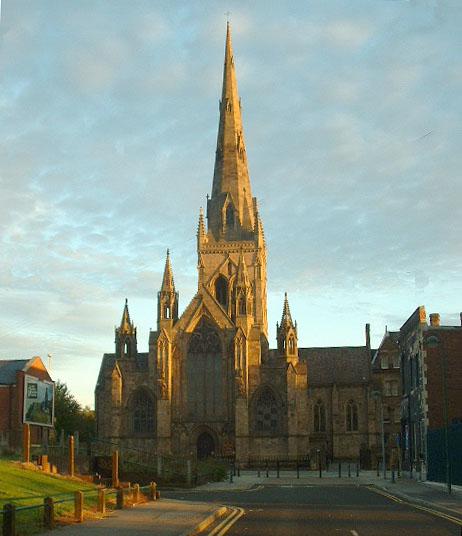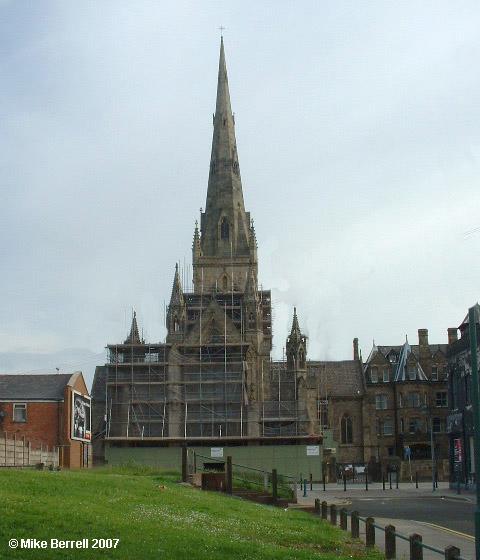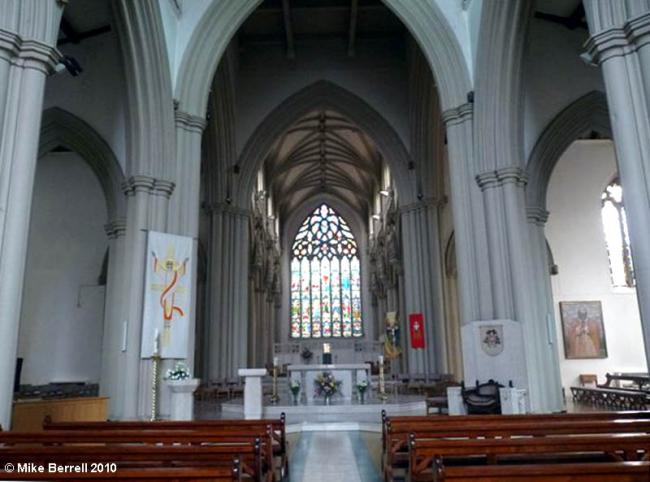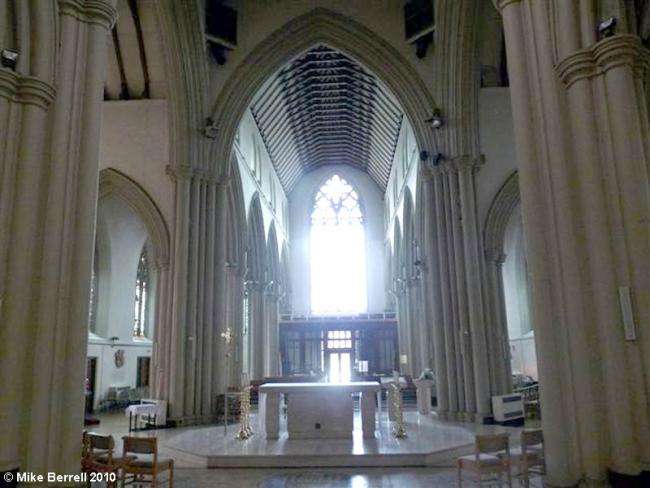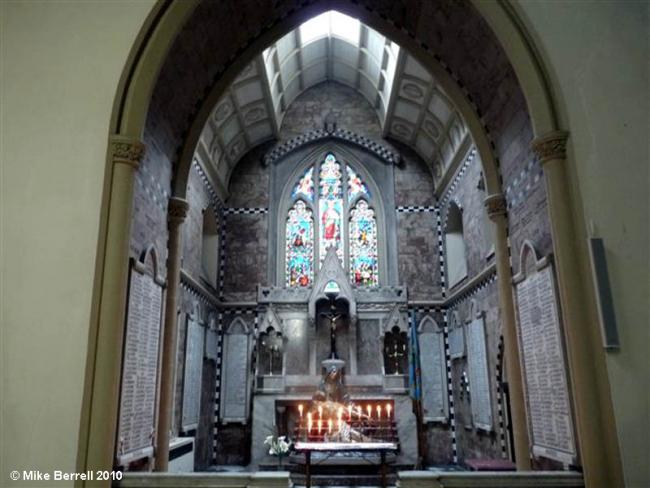Hide
St John the Evangelist (Cathedral), Salford, Roman Catholic
hide
Hide
Hide
Hide
It was founded in 1844.
It is hard for the Catholic of today, who is familiar with the number of Catholic Churches in Manchester, to realise that in 1840 there were only four churches in Manchester and none in Salford and Pendleton.The urgent necessity of building more churches was forced upon the Catholic population in a sudden and surprising way. One Sunday morning in 1835, when the faithful arrived for Mass at St, Mary's, Mulberry Street, they found that they were unable to enter the building, as the roof had collapsed the previous night. This unfortunate event called for an extra effort on the part of the Catholic population to provide themselves with new church accommodation. The Catholics were already busy collecting a penny a week towards a new church. It was decided to buy land at Hunt's Bank near the Victoria Station of to-day.
However, this was the age of railway expansion, and it soon became obvious that the building of new railways was going to make the Hunt's Bank site unsuitable for a church. So this was sold to the railways and a new site bought in Chapel Street, Salford, where the present cathedral was eventually built.
The Chapel Street site was solemnly and yet joyously inaugurated as a new Catholic place of worship on Whit Thursday, 1844. On that day ten Sundays schools of Manchester and three from Salford marched in procession to the site with bands playing and banners waving. Some six thousand took part, and the foundation stone of St. John's was laid and blessed by Dr. Sharpies, Bishop Coadjutor to Dr. Brown of Liverpool.
The work of building was helped forward in a practical way by the generosity of two Catholic families which had become prosperous in the textile trades of Manchester and Salford. The Leeming family and the family of Daniel Lee each contributed £1,000 - a notable figure in those days.
The architect chosen to design the new St. John's was a man of distinction in his profession, Mr. Matthew Hadfield of Sheffield. He was one of the generation who helped the builders of the last century to draw inspiration from the great works of the Catholic builders of the old abbeys and cathedrals. St. Mary's, Mulberry Street, and St. Mary's, Burnley, are also the works of this architect, and outside the diocese he is remembered for many churches built in the south and west of Ireland, for the lovely church of St. Marie's, Sheffield, and a fine Catholic parish church, known to many Manchester people, that at New Mills in Derbyshire. Mr. Hadfield designed for Salford the first Catholic Church since the Reformation to be made cruciform, or built in the form of a cross.
Because Salford was not then a Cathedral city, there was not at first any design for building at St. John's a great church like a cathedral. Yet, even as the church was building, the plans were much extended so that the builders must even then have hoped that they were erecting more than a parish church.
To complete the new and greater design, old school buildings had to be swept away, and new ones set up. All this put an added strain on the courage and the purses of the builders.
At last a great Gothic edifice rose on the site, some two hundred feet in length, and with a lofty spire two hundred and forty feet high, at that time the highest steeple ever built in Lancashire, and a symbol of the resurrection and the new life of the Catholic Faith, in spite of dungeon fire and sword.
The architect of the Cathedral had done his work well and it was praised by the great Pugin. Perhaps because the architect was a Yorkshireman, "the outside walls of the church were made of carved stone from the Yorkshire moors, although the interior was made of red sandstone. He had found inspiration for this new church in several old and beautiful churches, built in the ages of faith. The front of the church, abutting on Chapel Street, is inspired by the west front of Howden Church, Yorkshire." The choir and sanctuary are copied from the lovely Abbey church of the Benedictine monks of Selby, also in Yorkshire. The decorations of the groined roof are from a noble foreign building-the church of St. James at Liege."
The building of this great new church and the provision of suit able furniture and decoration are reported to have cost at that time some £18,000, a remarkable venture of, faith. It took more than forty years to clear away the large debt involved.
It was a day of great jubilation and a crowded social event when, on Wednesday, August 9, 1848, the Catholics of Manchester and Salford celebrated the opening of the new church. The Bishop of the diocese,"Dr. Brown, sang a solemn High Mass in the presence of eight English Bishops, a great concourse of priests and people, includ ing some aristocratic and noble families. Not since the Reformation had the Catholics of the North witnessed such a splendid and awe-inspiring presentation of the Catholic liturgy, with the Bishops in copes and mitres, six clerks carrying great branches of palm, deacons and celebrant in shining cloth of gold, and one hundred and twenty vested priests. The sermon was preached by the famous Bishop Nicholas Wiseman, later Cardinal, and renowned at that time as the best preacher in England. For one hour arid a half, Bishop Wiseman spoke beauti ful words of Christian, teaching to his great audience of more than 1600 people. Speaking of those, who had built so noble a church, he said, "Theirs is the confidence-notwithstanding the changes of the last three hundred years-that was felt by those of old who built churches, not for themselves or for their children, but for succeeding centuries, and who laboured to impress upon them by their massive-ness that theirs was a church founded upon the Rock of Ages, while by their spires they pointed to its never-failing hopes."
On this great occasion several distinguished laymen, amongst them the Lord Arundel and Surrey, took the collection among the faithful in order to reduce the church debt. The offerings were presented before the altar by the Architect arid Decorator of the church, bearing gold trays.
Inaugurating a long tradition of friendly relationship between the city and the Cathedral, the civic authorities had placed at the disposal of the Catholic community the Town Hall of Salford, where a collation for clergy and laity Bad been provided on the afternoon of the open ing day." The chairman of the" proceedings was Mr. Daniel Lee, and the friendly and cordial Catholic atmosphere of this memorable event may be summed up by the words of Bishop Sharples, who said, "By such gatherings the members of the Catholic Church are taught to feel as one family".
The only mark of hostility shown by outsiders at the opening of the new church was the distribution of an anti-Catholic pamphlet among the crowd of spectators who had gathered to witness the arrival of the distinguished strangers at the doors of the new church. Fortunately the bitterness of the pamphlet made no impression on either Catholics or Protestants, so that the great church of St. John's, Salford, was launched peacefully on its mission of peace.
Father George Errington, later famous as Archbishop Coadjutor to Cardinal Wiseman, was sent here in 1849 as Rector and remained until his appointment as Bishop of Plymouth. He js wrongly credited with building the Cathedral.
On July 25, 1851, the church, now made a Cathedral, was the scene of the consecration of its first Bishop, Dr. Turner, and of its former Rector, Dr. George Errington, as Bishop of Plymouth, at the hands of Cardinal Wiseman. For twenty-one years this great church was to be the object of the zeal and devotedness of its Bishop, of whom it could truly be said that he loved the beauty of God's House. In 1856 the Bishop installed the richly coloured and beautiful East window. It is said of him that in order to reduce something of the pressing burden of debt upon the Cathedral, the Bishop denied himself many of the comforts to which his labours might have entitled him. Death took him from the church he loved so well on July 17, 1872.
His successor, the great Bishop Herbert Vaughan, had the real joy and privilege of consecrating this cathedral church. Yet for that privilege he worked hard and had to wait nearly eighteen years. In the task of maintaining the Cathedral and of reducing the debt upon it, Bishop Vaughan was ably assisted by Canon Beesley, who was given charge of the Cathedral parish in 1874. At that time, the debt was £4,000, but before any real attempt could be made to remove it, Canon Beesley found that the Cathedral needed a thorough cleansing and re-decoration. Then in 1881, during the month of October, a great storm did considerable damage to the Cathedral spire. Canon Beesley worked hard to collect funds in order to repair the spire and overhaul all the external fabric of the building. In addition he supervised the build ing of a new Chapel of the Blessed Sacrament, so that the Cathedral might be well equipped for great Pontifical functions when the Bishop of the diocese came to preside over the church's more solemn ceremonies and sacred rites. This chapel was completed in 1884.
A tribute should be paid to the way in which the people of the Cathedral parish and of the Salford diocese, by acts of self-sacrifice and true generosity, helped to remove the debt on the Cathedral and so prepared the way for its solemn consecration as a place of Divine Worship. By 1890 the debt had become so small that a last effort was called for from priests and people, and on June 14, 1890, it was consecrated by Bishop Vaughan with the assistance of several Bishops; the altar of Our Lady was consecrated by Bishop Vaughan, and that of St. Patrick by Dr. Lacy, Bishop of Middlesbrough. On the following Sunday, the Mayor of Salford attended High Mass and the revered Bishop Hedley preached. Since that time the Cathedral Church of St. John has continued through the years its function as the principal church and spiritual centre of the diocese. At the same time it has fulfilled a no less necessary mission, namely, that of the parish church of a large and populous city district.
FROM AN OLD CHRONICLE
Thursday in Whitsun week is the day on which the annual procession of the children of Manchester and Salford takes place.
There was more than usual interest this year excited in consequence of the laying of the foundation stone of the new church in Salford on the procession day.
The children of the schools in Manchester and Salford were requested to assemble at their own schools at nine o'clock in the forenoon of Thursday. They did so, and from thence they proceeded to the site of the new church in Salford, where each of the schools arrived at about ten o'clock. A schoolroom had been lately fitted up, and is now used as a place of worship by the Catholics of Saltord, but a church or chapel had not been there since Catholicity was banished in the 16th century. The site of the new church is well situated. It is in front of the road leading to Pendleton, on the right hand side, a little above Salford Town Hall.
Everything was prepared for laying the foundation stone on Whitsun Thursday. The ground was levelled, and strong palings surrounded it. About ten o'clock a body of men, chiefly collectors for the church, were stationed inside the palings. The men and boys of Salford Guild were placed around the enclosure. On the arrival of the schools the teachers and scholars had places appointed for them, but members of the different guilds were all brought within the enclosure. About a quarter past eleven two Bishops-Dr. Briggs and Dr. Sharples-attended by twenty-five priests and other attendants, came on the ground. The bishops wore their mitres, and the clergy white surplices and caps.
They came in solemn procession from a newly erected Catholic school near the ground of the church. The ground was consecrated and the first stone of the new church was laid by the Right Rev. James Sharpies, Coadjutor Bishop of the Lancashire District. The ceremony was over about twelve o'clock noon. Then the general procession began to be formed, under the direction of the Rev. G. Freen, of St. Chad's Chapel. It was differently arranged from former Salford Processions. It proceeded from the site of the new church to the Crescent over the pay bridge (thirty shillings being paid for the procession to pass over). Thence through Lower Mosley Street to Picadilly. As St. Chad's was the first school in the procession, when it got to Dale Street it halted for a few minutes, and then marched off to its schoolroom, headed throughout by a band, a flag, the Rev. Croskell, a Worthy, and several gentlemen. After the procession the children had refreshments provided for them in their own schools, and in the evening, the teachers had a tea-party. - JOHN BIRD.
Taken from "Salford Diocese and its Catholic past", a survey by Charles A. Bolton, a Priest of the above Diocese. Published 1950 on the First Centenary for the Diocese of Salford.
This site provides historical information about churches, other places of worship and cemeteries. It has no connection with the churches etc. themselves. For current information you should contact them directly.
Original Registers
Baptisms
- 1843-1920 held by Lancashire Record Office RCSN
- 1843-1920 held by Lancashire Record Office RCSN
Marriages
- 1845-1948 held by Lancashire Record Office RCSN
- 1845-1948 held by Lancashire Record Office RCSN
Burials
- 1877-1880 held by Lancashire Record Office RCSN
- 1877-1880 held by Lancashire Record Office RCSN
Copies of Original Registers
Baptisms
- 1876-1912 held by Lancashire Record Office MF 1/276 279-282 - Microfilm
- 1876-1912 held by Lancashire Record Office MF 1/276 279-282 - Microfilm
- 1920-1941 held by Lancashire Record Office MF 1/276 279-282 - Microfilm
- 1920-1941 held by Lancashire Record Office MF 1/276 279-282 - Microfilm
- 1947-1962 held by Lancashire Record Office RCSF 2
- 1947-1962 held by Lancashire Record Office RCSF 2
Marriages
- 1856 held by Lancashire Record Office MF 1/276 279-282 - Microfilm
- 1856 held by Lancashire Record Office MF 1/276 279-282 - Microfilm
- 1917-1941 held by Lancashire Record Office MF 1/276 279-282 - Microfilm
- 1917-1941 held by Lancashire Record Office MF 1/276 279-282 - Microfilm
- 1947-1954 held by Lancashire Record Office RCSF 2
- 1947-1954 held by Lancashire Record Office RCSF 2
- 1961-1962 held by Lancashire Record Office RCSF 2
- 1961-1962 held by Lancashire Record Office RCSF 2
Indexes
Baptisms
- 1843-1934 held by Lancashire Record Office RCSN - Manuscript
- 1843-1934 held by Lancashire Record Office RCSN - Manuscript
Marriages
- 1845-1940 held by Lancashire Record Office RCSN - Manuscript
- 1845-1940 held by Lancashire Record Office RCSN - Manuscript
1843-1934
1876-1912
1920-1941
1947-1962
1845-1948
1856
1917-1941
1947-1954
1961-1962
- OpenStreetMap
- Google Maps
- StreetMap (Current Ordnance Survey maps)
- Bing (was Multimap)
- Old Maps Online
- National Library of Scotland (Old Ordnance Survey maps)
- Vision of Britain (Click "Historical units & statistics" for administrative areas.)
- English Jurisdictions in 1851 (Unfortunately the LDS have removed the facility to enable us to specify a starting location, you will need to search yourself on their map.)
- Magic (Geographic information) (Click + on map if it doesn't show)
- GeoHack (Links to on-line maps and location specific services.)

